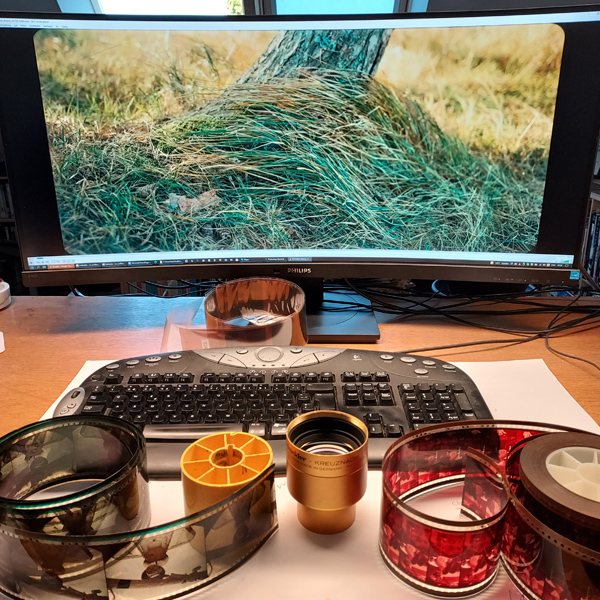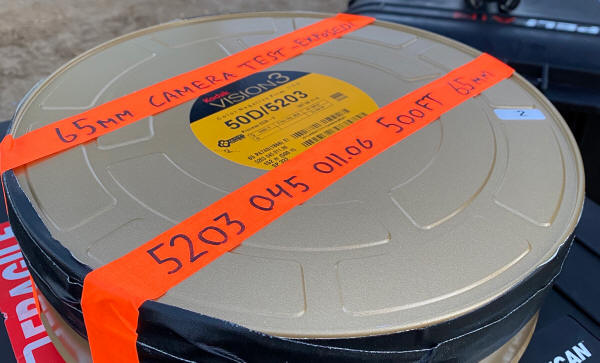The Invisible Magic Power of 70mm |
Read more at in70mm.com The 70mm Newsletter |
| Written by: Thomas Hauerslev | Date: 11.07.2021 |
 "It
seems there is some kind of invisible magic power that exists in the format,
so we would love to continue doing things with that format." Simon Wasiolek
June 15, 2021 in Copenhagen. Picture: Thomas Hauerslev "It
seems there is some kind of invisible magic power that exists in the format,
so we would love to continue doing things with that format." Simon Wasiolek
June 15, 2021 in Copenhagen. Picture: Thomas HauerslevIn January 2019 I met with Danish film makers and friends William Rudbeck Lindhardt, Simon Wasiolek and Ben Brahem Ziryab for a talk about their wish to produce something in 70mm. All in their 20s, a new generation of film-makers, and brought up with digital cinema and internet streaming. They have a wish - or an ambition - to shoot film on real film - not digital. Like vinyl LPs, "film" is perhaps making a comeback with the new generation of film makers it seems? Fast-forward to spring of 2021, and they sent me a link to view a roll of 65mm film they had shot in the Danish winter of 2020 in the lovely costal town of Tisvildeleje. A handful of scenes and with a running time of roughly 4˝ minutes (500 ft of film). The quality was impressive, just as it would be expected to be from 65mm. Very sharp pictures, lots of detail and a very pleasing look and feel. Simon's 65mm test is the most recent example of large format photography in Denmark. Previously, parts of "Tenet", "Samsara", “Song of Norway" and Louis de Rochemont's "Windjammer" were also shot in 65mm Panavison, IMAX and CineMiracle in Denmark. Pleased by their generosity to share this, and intrigued by seeing it, I reached out to Simon and suggested a meeting to catch up on developments. Simon brought William to the meeting too, which took place in a cafe by the harbour in Copenhagen. Simon and William enthusiastically talked about the experience of working with an authentic Mitchell 65mm camera, and getting some experience of the technology. I brought along some 65mm frame grabs of their test footage, which I had printed on color paper. They liked the magic of 70mm, as they had only seen the footage on screens so far. The 65mm roll had been developed and scanned by Cinelab London Ltd [UK] not far from Pinewood Studios. The 65mm test footage has yet to be printed to 70mm film. As our meeting progressed we talked about similar 70mm short films and how some of them they came about. |
More in 70mm reading: From YouTube To 65mm Film 65mm Todd-AO Concept Tests "As Good as it Gets" - Afterthoughts Panavision and the Resurrecting of Dinosaur Technology The Immersive Quality of 70mm Film Director of Photography Ben Brahem Ziryab in Conversation "Daughter of Dismay" World Premiere at the Schauburg |
 Grass
roots of 70mm Grass
roots of 70mmWhat is next for Simon and William, who are both currently working freelance? Their latest project - now in post production - is shot on 16mm film. They both recently attended the 70mm Festival at Gentofte Kino, and later in October they are considering going to the 70mm festival in Karlsruhe to see more 70mm film. I invited them to come and give a talk about their 70mm endeavours and share their experiences with the audience. Through their company Foton Film they have the ambition to make a feature film in 65mm with a very small crew. It will be like turning traditional film making upside down, and take the 65mm camera to the streets and start shooting. La Nouvelle Vague of the 2020s perhaps? Nothing is yet carved in stone but ideas are being considered. Maybe a road trip from A to B, a comedy or a tragedy etc? They are working on a story, and writing a lot. They do not have a web site yet, and they have yet to begin seek funding for the project. To be continued..... Six questions for Simon Wasiolek: Thomas: Please tell me about your project with the 65mm camera in Tisvildeleje [Denmark]. What was the idea, and did you achieve your goals? Simon: Well originally some of us from the original crew - Ben, William and myself - we made a short film on 35mm, and then we wanted to look into different formats that exist, and I started to discuss 65mm and 70mm. We wanted to see if it was possible to shoot something with a 65mm camera with a small crew to see how it would work with this camera. How would it look and feel, to prepare to see how it would work with a bigger project. |
|
 Director
of Photography Ben Brahem Ziryab
photographing Albert Rudbeck Lindhardt with the Fries-Mitchell 65mm camera on an ice cold
winter morning. Picture: Marcus McNair / Foton Film Director
of Photography Ben Brahem Ziryab
photographing Albert Rudbeck Lindhardt with the Fries-Mitchell 65mm camera on an ice cold
winter morning. Picture: Marcus McNair / Foton FilmWe were looking at different cameras until we were lucky enough to get our hands to a Fries-Mitchell 65mm camera from the '60s I believe. From that point on we bought one roll of Eastman Kodak Vision3 65mm 50D/5203 stock, and choose a week during winter [2020] to go out with a small crew. Just a focus puller, a director, the DOP - Ben - and a lighting assistant. Just four people went outside and made these shorts takes we felt interesting in some kind of cohesive way, and just shot with this roll of film, to test how it would feel to work in 65mm. Test if it would feel different. It did feel different. First of all, just in terms of the budget and the crew, and we were shooting everything on sticks [tripod], no handheld of course. You know it is a big heavy camera. It definitely makes you respect how to work with it, and I think we would love to look more into how we can work more with a camera like that, and find some kind of way to make the camera a bit more dynamic when we work on our next project. |
|
 Tisvildeleje,
60 km outside Copenhagen, winter 2020. Director
of Photography Ben Brahem Ziryab
adjusts focus. Bertil Rosenkrands Mathiesen is working with the 65mm camera. Picture: Marcus McNair / Foton Film Tisvildeleje,
60 km outside Copenhagen, winter 2020. Director
of Photography Ben Brahem Ziryab
adjusts focus. Bertil Rosenkrands Mathiesen is working with the 65mm camera. Picture: Marcus McNair / Foton FilmTHa: Did it live up to your expectations in terms of quality? Simon: Yes, it certainly did. It was amazing to see it for the first time. It was amazing to see the size of the picture, the color and the light. We really wish to see it on 70, because seeing it digitally does not really make it justice. To see the real deal, we would have to make a print of it. We are looking into doing that. THa: What kind of lenses did you use? Was it the same lens, or did you change lenses? Simon: It was a set of Hasselblad lenses, and as far as I remember, we had 3-5 different lenses to test with. Just in general we were just trying to - rather than really focus on an amazing product, it was really just to go out, and test the equipment and see how it could work. And also, since we are looking into possibly making a feature film in "70", or at least partly in "70", we would like to find a way to do that with a small, independent size crew. So we are trying to see if that is possible. A crew that is not going to be 200 people, unlimited budget so... So we are trying to see if that is possible. We haven’t really seen many people make a 70mm film like that. That was our aim with the test. |
|
 500
ft / 152 meters / 4˝ minute of exposed 65mm Eastman Kodak Vision3 50D/5203
stock. Picture: Marcus McNair / Foton Film 500
ft / 152 meters / 4˝ minute of exposed 65mm Eastman Kodak Vision3 50D/5203
stock. Picture: Marcus McNair / Foton FilmTHa: Has your test encouraged you to continue? Simon: Yes, very much so. First of all there is the - sort of - the feeling of respect when you are working with this format. You really feel inspired working in this way. And also the quality of the image. Especially the..., well, everything looks good. The landscapes, but also the close ups of the face. It seems there is some kind of invisible magic power that exists in the format, so we would love to continue doing things with the format. THa: What did the laboratory say? Simon: They were very excited and impressed about the result, and were curious to know more about the project. They were really welcoming about the project and supportive about what we did with it. Really good response. THa: What did your crew mates say about the result? Simon: They were very happy about it as well, especially that it worked out technically, and that every everything was in focus and looked good. It is something that people immediately talk about. When we were testing the camera in one of the rental houses here in Denmark, we had like 10 or 20 different DOPs who were visiting to say "Hi", and just to look at the camera, because no one even imagine that they would see a camera like that in these days. They were excited to see the camera, and also a little bit bewildered "Why is it here?" , "How did it get here?" and "Who do I have to call to get my hands on this camera?" [laughing]. |
|
| Go: back - top -
back issues -
news index Updated 22-01-25 |
